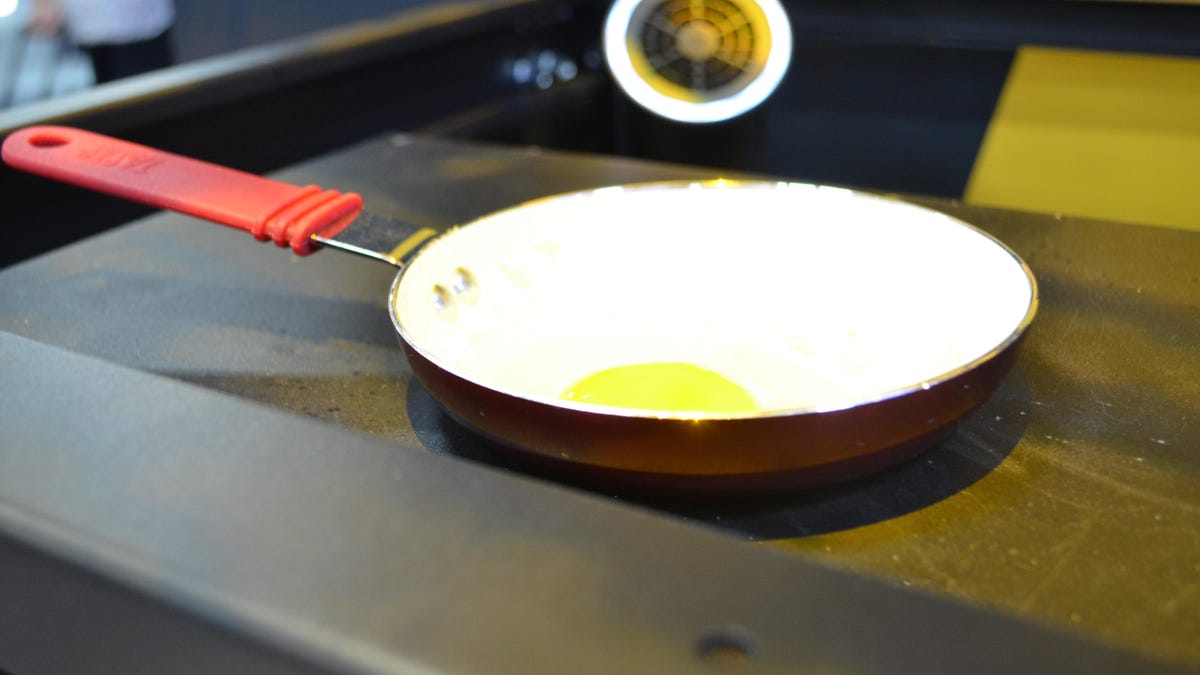This cryptocurrency-mining router got hot enough to fry an egg, so we did
It's the breakfast of champion hackers.

This egg is being cooked on top of a router that's overheated thanks to malware that mines for cryptocurrency. It tasted awful.
Serves: 1
Time: 20 minutes in a frying pan, 15 minutes directly on the router.
What you'll need:
- Eggs
- Cryptojacking malware
- Cooking spray
- A router
Fried eggs are a classic recipe, often cooked in a pan on top of a stove. But it's 2018, and in case you feel like you're living in a dystopian future, here's a hack to fry them on a router instead.
At the Black Hat cybersecurity conference in Las Vegas on Wednesday, Symantec showed off its cooking station -- an overheated router that surged up to 150 degrees Fahrenheit thanks to Coinhive, malware that infects devices and uses them to mine for cryptocurrency.
While cryptocurrency is all the rage, actually mining for it often isn't worth it because it requires powerful computers that eat up huge amounts of profit-killing electricity. Enter cryptojacking, which is when a hacker takes over someone else's machine and uses it to mine for cryptocurrencies like bitcoin or Ethereum.
The attacks are widespread, with researchers encountering cryptojacking malware on websites and hundreds of thousands of routers. In McAfee's June security report, the antivirus company said cryptojacking malware cases had spiked 629 percent from the last quarter of 2017 to the first quarter of 2018.
Symantec took an extreme approach to demonstrating the real dangers of cryptojacking. With the overheated router, it took 20 minutes to make one scrambled egg, over easy in a frying pan -- admittedly much longer than the usual cooking time on a stove. It cooks faster when it's directly on the router, Brian Varner, Symantec's special projects researcher, told me.
"We're trying to shed light on the kinetic effects of cryptojacking," Varner said. "They're stealing your electricity and putting a massive amount of wear and tear on your devices, and for what, six cents?"
Well, six cents and a poorly cooked egg.
During the time the egg was cooking, the mining malware actually made seven cents mining a cryptocurrency called Monero. By the time the egg was on a plate, that value had already dropped down to five cents.
Against my editors' recommendations, I decided to eat the egg as a food review.
You can see my "I regret this immediately" face here pic.twitter.com/lJGjUnUh4n
— alfred 🆖 @ the Black Hats and Def Cons 📍 (@alfredwkng) August 8, 2018
Taking my first bite, I expected the malware to at least add a little flavor.
Unfortunately, I really only tasted the extra virgin olive oil cooking spray that'd been fizzled onto the pan. The egg was runny, and the yolk quickly spilled out over the white. I finished the meal in two bites. I give this router-cooked egg one out of five stars.
It took too long to make the fried egg, and the Coinhive malware really did nothing for the taste. The egg whites were mostly flavorless, and cold. This wasn't a good egg.
How you cook something is often important when it comes to the final product. That's why people debate between grilling or pan-frying burgers. For eggs, it seems a frying pan beats a router. Check out the egg recipes over at our sister publication Chowhound. We recommend making your eggs the more-traditional way.
Security: Stay up-to-date on the latest in breaches, hacks, fixes and all those cybersecurity issues that keep you up at night.
Follow the Money: This is how digital cash is changing the way we save, shop and work.

